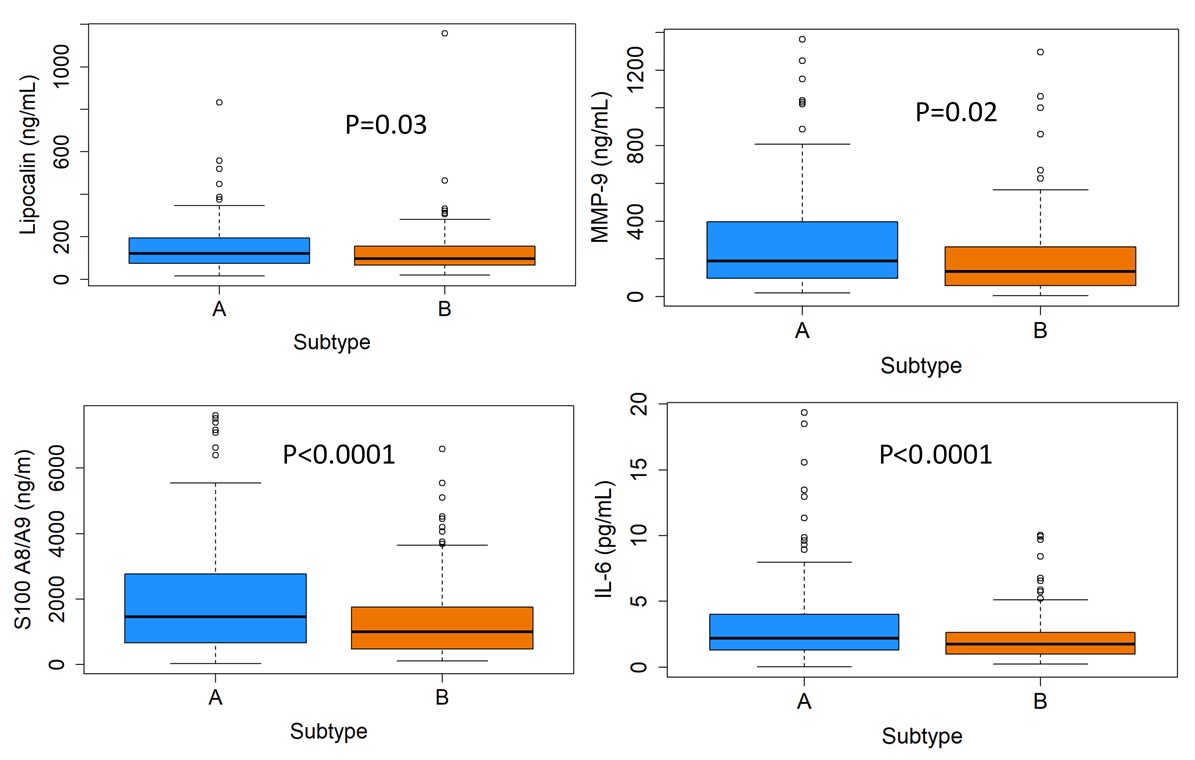Session Information
Date: Monday, November 13, 2023
Title: (1442–1487) SLE – Diagnosis, Manifestations, & Outcomes Poster II
Session Type: Poster Session B
Session Time: 9:00AM-11:00AM
Background/Purpose: Cognitive impairment (CI) is highly prevalent in patients with SLE [prevalence of 38% (range: 20%-80%)]. The exact mechanisms underlying CI is complex and multifactorial. Understanding the relationship between SLE CI phenotypes and analytes may be crucial for improving patient care and developing targeted interventions. We have previously defined two SLE CI subtypes (A and B) where subtype A performed worst on objective cognitive function compared with subtype B. Subtype A also, had greater levels of disease burden/damage, worse performance on subjective cognitive function, worse HRQoL and psychiatric measures compared with subtype B. We aimed to explore the associations between SLE CI phenotypes and serum analytes levels.
Methods: SLE patients aged 18-65 years attending a single lupus centre (January 2016 – October 2019) completed the ACR Neuropsychological Battery (ACR-NB) cognitive assessment. Age and gender matched normative data were used to obtain z-scores on all 19 tests of ACR-NB. The ACR-NB tests were reduced using principal component analysis (PCA). Similarity network fusion (SNF) was used to identify patient subtypes on the ACR-NB data, demographic and clinical variables, disease burden/activity, health related quality of life (HRQoL: SF-36, LupusQoL), the PDQ-20 (perceived cognitive deficits), Beck Depression Inventory-II, Beck Anxiety Inventory, and the fatigue severity scale (FSS) in addition to the serum levels of nine analytes (IL-6, IL-10, IFN-ɣ, MMP-9, NGAL/lipocalin, S100A8/A9, S100B, TNF-α, and TWEAK [determined by ELISA]). Differences between the SNF identified subtypes were evaluated using Kruskal-Wallis tests and chi-square tests.
Results: Of the 296 patients, 87% were female, mean age 41.5 ± 18.4 and mean disease duration 13.8 ± 10.1 years at study visit.The level of S100A8/A9, MMP-9, NGAL/lipocalin, and IL-6 were statistically significantly higher in the more severe SLE CI subtype A compared to B (Figure 1). No difference in the levels of IL-10, IFN-ɣ, S100B, TNF-α, and TWEAK were identified between SLE CI subtypes A and B.
Conclusion: This study demonstrated a higher level of serum analytes in association with the SLE CI subtypes identified with machine learning analysis. S100A8/A9, MMP-9, NGAL, and IL-6 levels were higher in the more severe subtype A where patients experience worse objective and and subjective cognitive function with a higher disease burden and damage compared with subtype B. The results of this study will further in deciphering the mechanisms of cognitive impairment in patients with SLE and the identification of targeted therapy.
Subtype A (blue) performed worst on objective cognitive function compared with subtype B. Subtype A also, had greater levels of disease burden/damage, worse performance on subjective cognitive function, worse HRQoL and psychiatric measures compared with subtype B (orange).
To cite this abstract in AMA style:
Barraclough M, Munoz-Grajales C, Erdman L, Diaz Martinez J, Bingham K, Kakvan M, Kretzmann R, Tartaglia C, Ruttan L, Choi M, Appenzeller S, Marzouk S, Bonilla D, Katz P, Beaton D, Goldenberg A, Green R, Wither J, Touma Z. Association of Serum Analytes with SLE Cognitive Impairment Phenotypes Formed by Machine Learning: MMP-9, S100A8/A9, IL-6, IL-10, and NGAL [abstract]. Arthritis Rheumatol. 2023; 75 (suppl 9). https://acrabstracts.org/abstract/association-of-serum-analytes-with-sle-cognitive-impairment-phenotypes-formed-by-machine-learning-mmp-9-s100a8-a9-il-6-il-10-and-ngal/. Accessed .« Back to ACR Convergence 2023
ACR Meeting Abstracts - https://acrabstracts.org/abstract/association-of-serum-analytes-with-sle-cognitive-impairment-phenotypes-formed-by-machine-learning-mmp-9-s100a8-a9-il-6-il-10-and-ngal/

